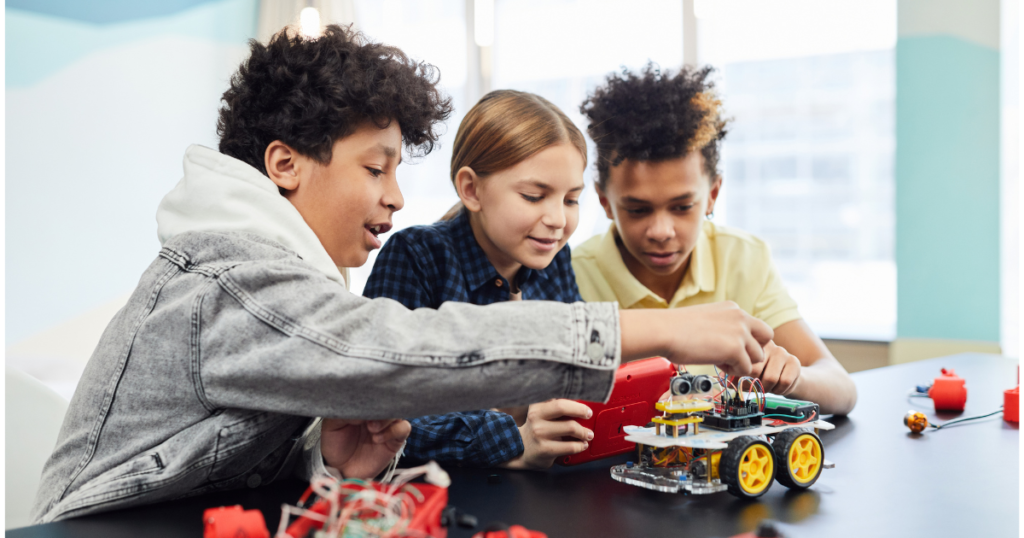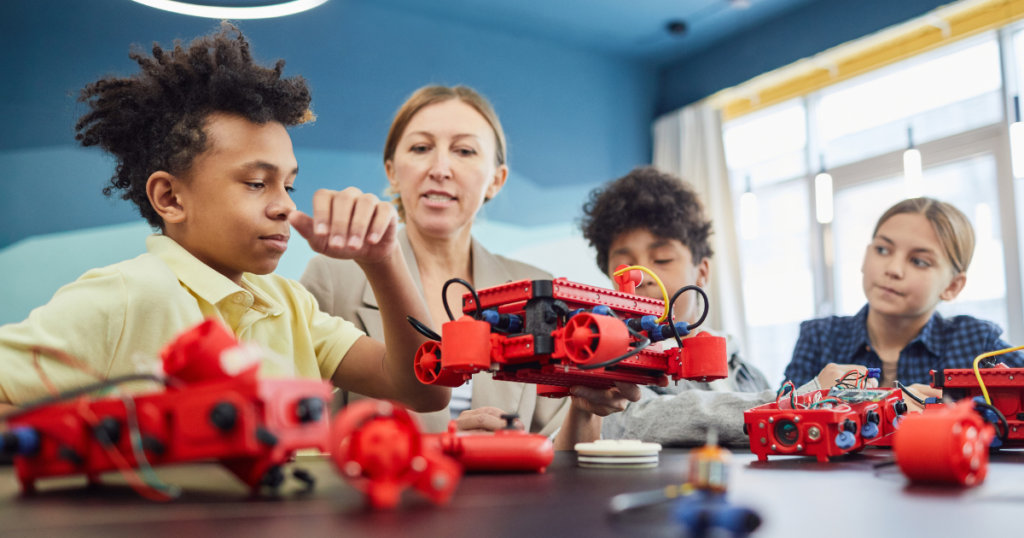Robotics provides children with an interesting method to educate them about science, technology, engineering, and mathematics (STEM). Robotics for kids stands as a fundamental ability for tomorrow because automation and artificial intelligence have increased since their emergence. Early robotics learning allows children to gain skills in problem-solving and creative thinking together with logical reasoning abilities.
Robotics extends past machine development because it enables children to discover creative solutions and put their concepts into reality. This article examines how robotics benefits children while presenting recommended robotic systems and step-by-step guidance alongside pleasurable activities for a satisfying learning experience.
The Importance of Robotics Education for Children Periodically:
The process of robotics creation encompasses much greater value than building interesting machines because it functions as a valuable tool for building future essential competencies. Here’s why it’s so important:
Encourages Problem-Solving & Creativity:
The robotic discipline provides children with challenges that require critical thinking along with the creation of innovative approaches. The learning process teaches young students to analyze complicated matters logically while also innovating unique problem solutions.
Builds STEM Skills:
Robotics for kids combines STEM fields of Science, Technology, Engineering, and Math into an interactive educational practice. The robotic system lets children experience coding together with electronic learning and basic mechanical concepts through interactive learning activities.
Enhances Logical Thinking:
Step-by-step planning alongside sequencing becomes crucial knowledge that teaches children about how things function. The ability to reason logically develops through robotics activities, making students proficient in many areas of academic and daily execution.
Boosts Confidence & Teamwork:
Children acquire self-assurance in their capabilities through the process of robot construction and programming. Several kids study robotics within teams which enables them to learn effective teamwork skills along with improved communication abilities.
Prepares for Future Careers:
Robotics for kids develop skills that lead them toward careers in artificial intelligence as well as automation fields and engineering sectors as technologies progress rapidly. Students who do not choose to pursue robotics careers will find their acquired skills useful for success in all types of professions.
Makes Learning Fun & Engaging:
Students learn through interactive activities since robotics stands different from conventional teaching methods. The subject makes complicated topics into challenging tasks, which keeps students both absorbed and enthusiastic about their lessons.
What is the best Age to Introduce Kids to Robotics?
Robotics for kids learning lacks set boundaries; however, the optimal time to begin depends on a child’s mental capacity along with personal interests. The following guideline serves as an introduction for beginners to start their robotics journey.
Ages 3-5: Early Exploration
Kids at this age become ready to practice problem-solving and refine their motor skills by using basic robotics toys that exclude screens like coding blocks and story-based interactive robots. The toys use entertaining methods to teach basic cause-and-effect principles during sequential learning activities.
Ages 6-9: Hands-On Learning
Beginner robotics enthusiasts should choose the LEGO Boost or Botley robotics kits to learn at this time. Children during these stages should experience basic programming together with robot assembly skills and fundamental mechanical learning. The coding language Scratch enables visual programming that lets users learn computer programming fundamentals easily.
Ages 10-13: Deeper Engagement
The learning capabilities of pre-teens extend to programming tasks combined with sensor systems and AI ideas. Using Arduino together with Raspberry Pi as well as LEGO Mindstorms enables students to understand professional robotics while solving creative problems.
Ages 14+: Advanced Robotics
Young people who want to explore robotics can study Python and C++ programming languages alongside complex robotics platform use and FIRST Robotics or VEX Robotics competitive work. The middle academic division possesses the potential to explore automation as well as machine learning and practical engineering applications.
How Robotics Enhances STEM Learning?
The strategic tool Robotics creates direct interactions between Science, Technology, Engineering, and Mathematics in the real world. The educational practice allows students to visualize STEM topics through hands-on activities that prepare them for future competencies. The following benefits describe how robotics improves STEM education:

Robotics for Kids makes Learning Interactive & Fun:
Traditional STEM education presents concepts as abstract ideas, but robotics enables these concepts to become functional applications. Children gain exciting experiences from robotics since they learn to see physics principles alongside coding and engineering methodology through robot building and programming activities.
Encourages Problem-Solving & Critical Thinking:
Robotics projects present two major challenges to young students: the task of moving their robots accurately and the requirement of fixing their code. The experiences push students to learn analytical problem-solving, logical thinking, and creative problem development.
The Program Demonstrates Practical Methods of Learning Codes:
Learning programming principles becomes achievable through robotics because students can write instructions for robot movement along with completing various tasks and executing interactions. Beginning programmers find helpful visual languages in Scratch whereas Python and C++ work well for more experienced students.
Develops Engineering & Mechanical Skills:
Robot assembly allows children to discover gear operations, sensor mechanics, and electric circuit functionality. The practical construction method creates strong engineering and technological knowledge bases.
Strengthens Math Skills:
Robotics requires the natural integration of mathematical concepts because students must approach tasks such as distance measurement and angle computation along with speed calculation. Students learn to use mathematical reasoning in daily practical situations, which develops their capacity to calculate and demonstrates analytical behaviors.
Encourages Teamwork & Collaboration:
Children develop their teamwork along communication abilities through the group-based nature of robotic activities. The process teaches these students to collaborate by sharing their concepts through proper delegation of responsibilities so they can reach their shared purpose in the same manner as engineers and scientists do in reality.
Prepares for Future Careers:
Through robotics, children acquire relevant skills of the 21st century, which they need to succeed in artificial intelligence together with automation as well as engineering fields. The ability to solve problems and analyze situations that students develop through robotics will help them excel in any profession, even though they may not become robotics experts.
Young children who learn robotics develop several major benefits:
Early robotics education produces substantial positive effects on the intellectual growth alongside creative expression and social interaction of children. Young learners who participate in robotics learn multiple advantages that include the following crucial points:
Boosts Problem-Solving Skills
Robotics forces students to analyze problems while fixing them which enables them to build exceptional problem-solving capability that applies throughout every life situation.
Strengthens STEM Skills
Robotics combines four fundamental educational fields (STEM) into hands-on experiments, which enhance complex learning opportunities for students and keep them interested in schoolwork.
Encourages Creativity & Innovation
Children can use robot-design activities to discover new ideas by testing different approaches through programming. The process enables innovation alongside the development of creative thinking.
Develops Logical & Computational Thinking
Robot programming enables children to grasp programming logic, which prepares them for encoding and scientific computing studies through algorithm acquisition.
Improves Hands-On & Technical Skills
Robot assembly with wiring and sensor utilization provides kids an opportunity to practice precision motor skills while learning practical engineering ideas.
Builds Confidence & Perseverance
The success of robot programming, together with problem resolution, enables children to experience achievement. The process of developing their designs by overcoming mistakes strengthens both perseverance and resilience in students.
Encourages Teamwork & Collaboration
The nature of robotics activities promotes teamwork and leadership development in addition to fostering effective communication skills when children collaborate toward shared objectives.
Prepares for Future Careers
Robotics prepares students for success in the sectors of modern technology alongside engineering art, artificial intelligence, and automation, which are essential in current digital environments.
Enhances Focus & Patience
Robotics demands kids to devote both detailed focus and patient work as they follow procedures and test their conceptual designs and project refinements. Their ability to concentrate, along with their persistence rate, increases.
Makes Learning Fun & Engaging
Robotics provides a stimulating, practical approach to education that makes students interested in studying new subjects.
Fun Ways to Teach Robotics to Kids:
Hands-on Kits & Projects Active learning is enhanced by letting students use VEX or LEGO Mindstorms robotics kits to create robots while developing their creative and problem-solving capabilities.
Gamified Coding: Code.org, along with Blockly, provides learning platforms featuring thematic games that use interactive code challenges for teaching code basics.
Competitions & Challenges: Binary 2 Uses robot races along with sumo battles and scavenger hunts as competitions and challenges to transform educational experiences into competitive activities with an exciting tone.
Collaborative Learning: The act of collaborative learning can be developed when students build and program robots alongside their peers to learn both teamwork and communication abilities.
Robotics in Everyday Life: The real-world effects of robots in healthcare spas,ce exploration, and agricultural industries should be demonstrated to students since this will activate their interest and provide practical knowledge about robotics in daily life.
Best Robotics Kits for Beginners:

The following list includes excellent robotics kits targeted at beginner students who want engaging learning experiences with simple operating interfaces:
LEGO Mindstorms Robot Inventor Kit
Why it’s great: This product links the building aspects of LEGO pieces to its user-friendly coding interface. Great for kids aged 10+.
Features: The kit contains motors together with sensors and a programming interface named LEGO Hub. The software uses a mobile application to let users design codes that come with multiple coding projects.
VEX Robotics VEX GO
Why it’s great: The robotics kit is ideal for beginners because it enables children to build and program their way into robotics foundation concepts.
Features: The system allows simple assembly configurations and functions through VEXcode programming software. Suitable for kids aged 8+.
Ozobot Bit Coding Robot
Why it’s great: The robot’s compact size makes it popular because it provides an introduction to programming through color command and block-style code.
Features: The VEX GO offers a portable design together with straightforward programming functions suitable for children between ages 6+ because of its simplicity.
Sphero Mini
Why it’s great: The small robot ball provides children with programming control through basic application access. This device provides entertaining basic programming practice that works well for beginners approaching computer code.
Features: The app-based programming integrates gyroscopic sensors while offering plenty of engaging interactive tasks as a main feature. Ideal for ages 8+.
Thymio V2 Robot
Why it’s great: Users appreciate this robot because it was developed expressly for new learners to gain programming skills while they use sensors combined with basic commands.
Features: The platform enables text-based programming and block-based coding which allows children from ages 7 and older to use it.
Online Courses and Resources for Kids to Learn Robotics
Children can find suitable online courses and training materials for robotics knowledge at these excellent platforms:
Code.org
What it offers: Learning robotics and basic coding through Code.org can be obtained for free with their games and lesson content.
Recommended for: Ages 6-18.
Key features: This resource features three main components which include block-based programming and robot-themed activities and coding challenges.
Link: Code.org
TinkerCAD by Autodesk:
What it offers: The platform provides children with free electronic and robotic design capabilities through its beginner-friendly 3D software.
Recommended for: Ages 8+.
Key features: Its main features include a basic graphic element combination tool for building both 3D designs and electronic circuit models.
Link: TinkerCAD
Khan Academy (Computing Section):
What it offers: The program at Khan Academy delivers interactive instruction about computer programming together with computational thinking principles which form the base for robotics knowledge.
Recommended for: Ages 10+.
Key features: Users can access free programming, algorithm and coding education through Khan Academy while progressing through their interactive lessons and complications.
Link: Khan Academy – Computing
4. Robot Shop Academy:
What it offers: Through its educational offerings the organization teaches students to construct programmable robots by using devices such as Arduino along with Raspberry Pi and LEGO Mindstorms.
Recommended for: The course targets students aged 10 years and older who should use adult guidance for advanced projects.
Key features: The training program provides complete step-by-step robotic tutorials, starting from beginner classes and progressing through advanced levels.
Link: Robot Shop Academy
5. Coursera (Introduction to Robotics)
What it offers: Through its program, Coursera provides robotics courses that serve students ranging from children to teenagers. The curriculum includes basic robotics classes for beginners and programmed robot introduction courses.
Recommended for: Ages 12+.
Key features: University-level courses from the University of Pennsylvania enable students to develop skills in robot design combined with programming methods.
Link: Coursera – Robotics
Careers in Robotics:
Robotics Engineer: The role of Robotics Engineer focuses on robot design and construction for healthcare together with space exploration operations.
AI Specialist: The AI Specialist establishes “thinking” algorithms for robots that help robots solve dilemmas.
Robotics Software Developer: A Robotics Software Developer uses code to control both robot movement and robotic actions.
Healthcare Robotics: Robotics in Healthcare addresses robot developments to assist medical staff during operations and patient assistance activities.
Robotics Research Scientist: The Robotics Research Scientist develops innovative robot systems and their future applications for practical use.
Drone Engineer: The drone engineer creates drone platforms for transportation purposes and aerial imaging solutions as well as aerial survey work.
Robotics Educator: Robotics Educators provide robot instruction to students to develop the engineers of tomorrow.
Conclusion:
Robotics presents children with an active learning environment to build strong skills that determine their upcoming achievement potential. Students develop important abilities through robotics because this hands-on educational experience enables STEM disciplines to exist in a dynamic learning environment. Young students who explore robotics learn at a young age and gain better technical skills and mathematical proficiency while developing essential traits of perseverance and teamwork and increasing their self-confidence. The adoption of robotics education will grow essential because it shapes children to enter careers involving engineering together with automation and artificial intelligence. Learning through robotics creates an enjoyable learning experience that cultivates innovation-related interest and lasting enthusiasm in students.


